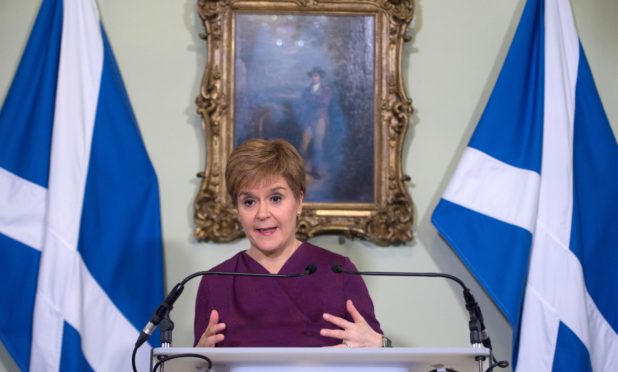First Minister Nicola Sturgeon yesterday through down the gauntlet of a second referendum on independence to Prime Minister Boris Johnson following the “material change” of Brexit.
Ms Sturgeon, who claimed “even the dogs in the street” knew Scotland was going to have a second vote in separation from Westminster, unveiled proposed legislation which would make a vote “beyond legal challenge”.
The Scottish Government is demanding the transfer of powers from Westminster to Holyrood which would allow for referendums and timings to be decided by the Scottish Parliament.
Ms Sturgeon wants to hold a vote in 2020 — the precise timing of which is “to be chosen by the Scottish Parliament”.
In her Scotland’s Right To Choose release, the SNP leader highlight’s Scotland’s existence as a “nation…not a region” and that the decision on whether Scotland should be independent should be for the Scottish people to decide.
The SNP returned 47 MPs to Westminster at last week’s election, which they said gives them the mandate to demand a second independence contest.
A request for a section 30 order has been sent by the first minister to Downing Street ahead of the Christmas recess.
But Ms Sturgeon said she expects a “flat no” from Mr Johnson and the Conservative government.
She said: “The document we are publishing turns the question on its head.
“It is for the Prime Minister to defend why he believes the UK is not a voluntary union of equal nations.
“It is for him to set out why he does not believe people in Scotland have the right to self-determination.
“And it is for the Prime Minister to explain why he believes it is acceptable to ignore election after election in Scotland and to override a democratic mandate stronger than the one he claims for his Brexit deal.
“We live in a democracy and ultimately democracy must and will prevail.”
The Chancellor of the Duchy of Lancaster, Michael Gove said: “We had a referendum in 2014 and at the time everyone agreed the result of that referendum would be agreed for a generation. Nicola Sturgeon and Alex Salmond signed the Edinburgh Declaration on the basis this referendum would be held and we wouldn’t have another one for a whole generation to come.
“So I think on that basis we should respect the referendum result and politicians across the United Kingdom should be concentrating on the issues that really matter to people: improving the NHS, fighting crime and helping to improve education.
“The Scottish Government have a lot on their plate. My friends and family in Scotland want them to concentrate on improving the NHS, making sure Scottish schools are better. I want to work with the Scottish Government to make sure Scottish people’s lives are better.”
Meanwhile the Referendums (Scotland) Bill, which seeks to lay out a framework for how future votes in Scotland are carried out, has been passed by MSPs.
But opposition parties have claimed it is nothing more than a method of getting to a second independence ballot.
The Bill passed by 68 votes to 54, with two MSPs abstaining.
Constitutional Relations Secretary Michael Russell said: “With this legislative framework in place, it only requires a short Bill for an independence referendum to be held once a transfer of power, which puts holding a referendum beyond challenge, is devolved to the Scottish Government.”
Tory constitutional relations spokesman Adam Tomkins and Labour constitution spokesman Alex Rowley both argued the provisions in the Bill around the questions used in referendums were an attempt to “rig” any future vote by the SNP.
The legislation allows for questions that have been approved by the Electoral Commission to be used again within the parliamentary term.










